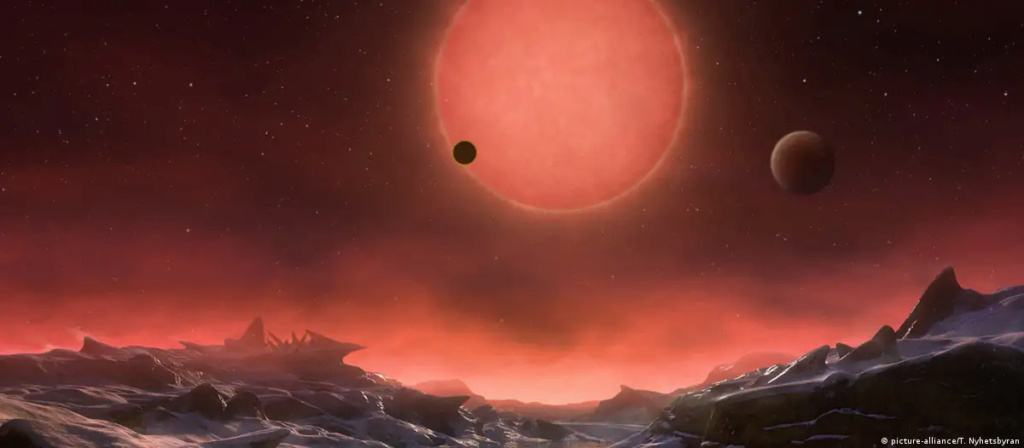The discovery of the first space water on a planet outside the solar system

The adventure of space discovery relies on finding other forms of life outside our planet (NASA.gov website)
A space land suitable for human habitation, which represents the "biggest step" in proving that man is not unique in the universe
In a precedent of its kind, astronomers found water vapor on a planet of the type that is classified as a "super-Earth", and that term is used to describe rocky planets outside our solar system, which are similar to Earth, but exceed it in mass and magnitude. This is considered a major step forward in the search for living forms in the vast cosmic space.
And by extension, that planet, known as "K2-18b", is perhaps the best candidate seen so far, providing support for the theory of the existence of life on worlds other than Earth.
In this regard, Bjorn Beneke, an astronomer at the University of Montreal, Canada, who worked on the study on K2-18b, said that the discovery "represents the biggest step so far towards achieving our ultimate goal of finding life on other planets, with the aim of proving that we "We are not alone in the universe. Thanks to our observations and our model of the planet's climate, we have shown that water vapor there can condense into liquid water. This is a first of its kind."
On the other hand, scientists believe that another study on K2-18b may lead to the discovery of more molecules that are key to life on Earth, such as nitrogen and methane. They also believe that additional tracking of more than 4,000 other planets outside the solar system may lead to finding similar promising worlds.

In that context, it is correct to say that this exoplanet was spotted for the first time in 2015, but researchers only discovered the presence of water on its surface in recent research.
The currently approved equipment can only determine basic factors such as distance, mass and temperature, but the advanced tools developed by the British University College in London helped read the data provided by the Hubble space telescope, which led to an understanding of the unique molecular fingerprints related to the existence of water vapor on that planet.
By extension, K2-18b is classified as a super-Earth because it is twice as massive and eight times heavier than our planet. Since it's so far away, astronomers can't see it, but they can see how starlight passes through the planet's atmosphere as it orbits its own sun, called K2-18.
Scientists also noticed that the distance between the planet and its star is much closer than the distance between the earth and its sun, which means that its rotation around its sun takes only about 33 days.
In this regard, Dr. Angelos Tsiaras, the principal investigator of the study, explained, "K2-18b is the only planet outside our solar system that we know has a temperature suitable for the existence of life, as well as an atmosphere and water."
On the other hand, it should be noted that "K2-18b" does not necessarily represent "the second Earth, because it is much larger than our planet Earth, and the composition of its atmosphere is different from that surrounding our Earth... It revolves around a completely different star (compared to our sun), so it is not similar." K2-18b "Our planet... The search for habitable planets is very exciting, but it always reminds us that Earth is our only home, and perhaps the possibility of us traveling to other planets is a totally out of the question step," says Tsiaras.

Although the planet falls within the so-called habitable zone, scientists believe that telescopes available at the present time are unable to notice signs of life on it. Additional monitoring is needed to confirm that it is habitable for life on its surface.
As such, the scientists, who published their findings in the journal Nature Astronomy after more than a year of effort, believe the water content on the planet's surface may be as low as 0.01 percent or as high as 50 percent.
Commenting on this, Dr. Ingo Waldman, co-author of the study, said, "We do not know the amount of water on the planet, yet what the available models show indicates the presence of water and an atmosphere there."

In this regard, the researchers believe that K2-18b is not the only potentially habitable "super-Earth". They also expect to find other planets that do not vary greatly in their characteristics, among the more than four thousand planets outside the solar system that were discovered at earlier times.
In this way, scientists hope that new technologies such as the "James Webb Space Telescope", which is scheduled to be launched in March 2021, will solve more mysteries outside the scope of our solar system.
Based on these data, Dr. Tsiaras expressed that he "is looking forward to the next generation of telescopes, so that we can go much further."
Source: websites

